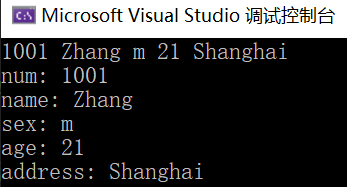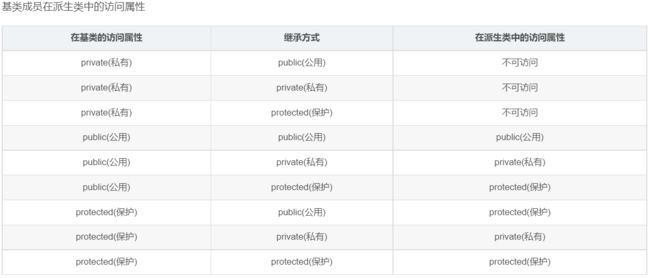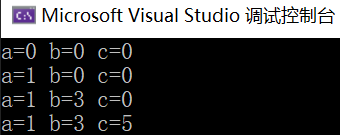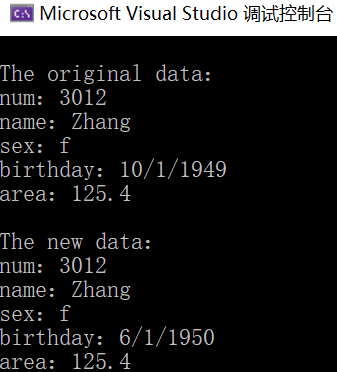C++程序设计 上机实验(第11章——继承与派生)
1. 共用继承方式、私有继承方式和保护继承方式的对比
#include- 程序分析:
- 将程序22行中的继承方式public(公用的)改为private(私有的)或protected(保护的),都能得到以下的运行结果
- 运行结果:
2. 对上题的程序修改、补充
#include将上题中基类的私有成员改为保护成员,另外将派生类的继承方式指定为public,同时在display1函数中输出基类的保护成员,此时得到的运行结果与上题相同。如果将派生类的继承方式指定为protected,程序也能正常运行,结果不变。但这并不意味着二者可以相互代替,一般情况下,用public和用protected声明继承方式是不等价的。
3. 有以下程序结构,请分析访问属性
class A //A为基类
{
public:
void f1();
int i;
protected:
void f2();
int j;
private:
int k;
};
class B :public A //B为A的公用派生类
{
public:
void f3();
protected:
int m;
private:
int n;
};
class C :public B //C为B的公用派生类
{
public:
void f4();
private:
int p;
};
int main()
{
A a1; //a1是派生类A的对象
B b1; //b1是派生类B的对象
C c1; //c1是派生类C的对象
}
| 在基类的访问属性 | 继承方式 | 在派生类中的访问属性 |
|---|---|---|
| public(公用) | public(公用) | public(公用) |
| protected(保护) | public(公用) | protected(保护) |
| private(私有) | public(公用) | 不可访问 |
(1)在main函数中能否用b1.i,b1.j和b1.k引用派生类B对象b1中基类A的成员?
- 可以用b1.i引用对象b1中的基类A的成员i,因为它是公用数据成员。
- 不能用b1.j引用对象b1中的基类A的成员j,因为它是保护数据成员,在类外不能访问。
- 不能用b1.k引对象b1中的基类A的成员k,因为它是私有数据成员,在类外不能访问。
(2)派生类B中的成员函数能否调用基类A中的成员函数f1和f2?
- 可以调用基类A中的成员函数f1和f2,因为f1是公用成员函数,f2是保护成员函数,B对A是公有继承方式,因此它们在派生类中仍然保持原有的访问权限,可以被派生类的成员函数访问。
(3)派生类B中的成员函数能否引用基类A中的数据成员i,j,k?
- 可以引用基类A中的数据成员i和j,因为它们在派生类中是公用成员和保护成员,可以被派生类的成员函数访问。不可以引用基类A中的数据成员k,它在派生类中是不可访问的成员。
(4)能否在main函数中用c1.i,c1.j,c1.k,c1.m,c1.n,c1.p引用基类A的成员i,j,k,派生类B的成员m,n,以及派生类C的称员p?
- 可以用c1.i引用对象c1中基类A的成员i,不能用c1.j,c1.k引用基类A的成员j和k,因为它们是保护成员和私有成员,不能被类外访问。也不能访问c1中派生类B的成员m,n,它们也是保护成员和私有成员,不能被类外访问。也不能访问派生类对象c1中的私有成员p
(5)能否在main函数中用c1.f1(),c1.f2(),c1.f3()和c1.f4()调用fl,f2,f3,f4成员函数?
- 可以调用成员函数f1,f3,f4,它们是公用成员函数。不能调用成员函数f2,因为它是保护成员函数
(6)派生类C的成员函数f4能否调用基类A中的成员函数f1,f2和派生类中的成员函数f3?
- 可以,f1,f3是公用成员函数,f2是保护成员函数,都可以被派生类C的成员函数调用
4. 有以下程序结构,请分析所有成员在各类的范围内的访问属性
class A //A为基类
{
public:
void f1();
protected:
void f2();
private:
int i;
};
class B :public A //B为A的公用派生类
{
public:
void f3();
int k;
private:
int m;
};
class C :protected B //C为B的保护派生类
{
public:
void f4();
protected:
int m;
private:
int n;
};
class D :private C //D为C的保护派生类
{
public:
void f5();
protected:
int p;
private:
int q;
};
int main()
{
A a1; //a1是派生类A的对象
B b1; //b1是派生类B的对象
C c1; //c1是派生类C的对象
D d1; //d1是派生类D的对象
}
| 在基类的访问属性 | 继承方式 | 在派生类中的访问属性 |
|---|---|---|
| public(公用) | public(公用) | public(公用) |
| protected(保护) | public(公用) | protected(保护) |
| private(私有) | public(公用) | 不可访问 |
| public(公用) | protected(保护) | protected(保护) |
| protected(保护) | protected(保护) | protected(保护) |
| private(私有) | protected(保护) | 不可访问 |
| public(公用) | private(私有) | private(私有) |
| protected(保护) | private(私有) | private(私有) |
| private(私有) | private(私有) | 不可访问 |

根据以上的分析,可以知道:
(1)在派生类外,可以通过对象调用f5函数,如d1.f5()。其他成员均不能访问。
(2)派生类D的成员函数f5可以访问基类A的员f1和f2,派生类B的成员f3和k,派生类C的成员f4和m,派生类D的成员p和q。
(3)派生类C的成员函f4可以访问基类A的成员f1和f2,派生类B的成员f3和k,派生类C的成员n和m
(4)派生类B的成员函数f3可以访问基类A的成f1和f2,派生类B的成员k和m。
(5)基类A的成员函数f1可以访问基类A的成员f2和i
5. 有以下程序结构,请输出运行时的结果
#include运行结果:
6. 有以下程序结构,请输出运行时的结果
#include程序分析:
- 在main函数中,建立C类对象c1,由于没有给出参数,系统会执行默认的派生类C的构造函数。但在执行函数体之前,先要调用其直接基类B的构造函数。同样,在执行构造函数B的函数体之前,要调用基类A的构造函数。输出
constructing A,然后返回构造函数B,执行构造函数B的函数体,输出constructing B,然后返回构造函数C,执行构造函数C的函数体,输出constructing C,在建立对象c1之后,由于main函数中已无其他语句,程序结束。- 在结束时,要释放对象c1,此时,先调用派生类C的析构函数,根据规定,先执行派生类C的函数体,输出。然后调用派生类C的直接基类B的析构函数,同样,先执行类B的函数体,输出。再调用派生类B的直接基类A的析构函数,执行类A的函数体,输出。
运行结果:
7. 分别声明Teacher(教师)类和 Cadre(干部)类,采用多继承方式由这两个类派生出新类Teacher_Cadre(教师兼干部)类。要求:
(1)在两个基类中都包含姓名、年龄、性别、地址、电话等数据成员
(2)在Teacher类中包含数据成员title(职称),Cadre类中还包含数据成员post(职务)。在Teacher_Cadre类中还包含数据成员wages(工资)
(3)对两个基类中的姓名、年龄、性别、地址、电话等数据成员用相同的名字,在引用这些数据成员时,指定作用域
(4)在类体中声明成员函数,在类外定义成员函数
(5)在派生类Teacher_Cadre的成员函数show中调用Teacher类中的display函数,输出姓名、年龄、性别、职称、地址、电话,然后再用cout输出职务与工资
#include运行结果:
8. 在程序中使用继承和组合。在定义Professor类对象prof1时给出所有数据的初值,然后修改prof1的生日数据,最后输出prof1的全部最新数据。
#include运行结果:






